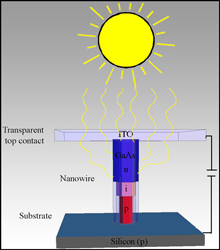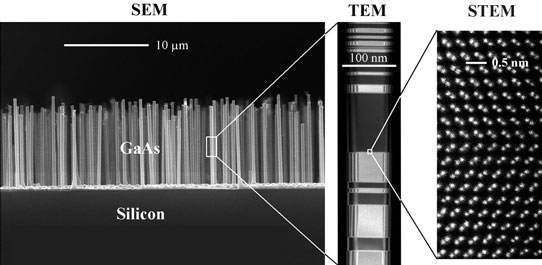- News
12 April 2013
GaAs nanowires boosts solar cell efficiency beyond Shockley–Queisser limit
Scientists from the Niels Bohr Institut in Denmark and the Ecole Polytechnique Fédérale de Lausanne (EPFL) in Switzerland have shown that a single core–shell p–i–n junction gallium arsenide (GaAs) nanowire (grown on a silicon substrate) can concentrate sunlight by up to 15 times in intensity. The team says the results are “surprising” and that they show “great potential for developing a new type of highly efficient solar cell”.
Nanowires are extremely small filaments – in this case able to capture light – with a diameter that measures somewhere from tens to hundreds of nanometers. Due to the unique physical light absorption properties of such nanowires, the limit of how much energy that can be utilized from the sun’s rays is now higher than previous believed, say the researchers. “These results demonstrate the great potential of development of nanowire-based solar cells,” comments Dr Peter Krogstrup of the Niels Bohr Institut. The work was first described in paper ‘Single-nanowire solar cells beyond the Shockley–Queisser limit’ in the journal Nature Photonics 7, 306 (24 March 2013); doi: 10.1038/nphoton.2013.32.
In recent years, research groups have been studying how to develop and improve the quality of the nanowire crystals. Nanowires are expected to have great potential in the development not only of solar cells, but also of future quantum computers and other electronic products.
 Picture:
The sun's rays are drawn into a nanowire, which stands on a substrate. At a given wavelength the sunlight is concentrated up to 15 times. (Courtesy of Niels Bohr Institute.)
Picture:
The sun's rays are drawn into a nanowire, which stands on a substrate. At a given wavelength the sunlight is concentrated up to 15 times. (Courtesy of Niels Bohr Institute.)
Standing vertically, nanowires can concentrate photons from the sun into a small area in the crystal by a factor of up to 15. Because the diameter of a nanowire crystal is smaller than the wavelengths of the light from the sun it can cause resonances in the intensity of light in and around nanowires.
Thus, the resonances can produce ‘concentrated’ sunlight where the energy is converted, which can achieve a higher conversion efficiency of the sun’s energy, says Krogstrup, who with this discovery claims to have given “a real boost” to research in solar cell technology based on nanowires.
Improved efficiency
Furthermore it appears that the typical solar cell conversion efficiency limit – the so-called ‘Shockley-Queisser limit’ – may now be significantly increased. “It's exciting as a researcher to move the theoretical limits,” comments Krogstrup. “That the limit may be moved by only a few percent will have a major impact on the development of solar cells, the exploitation of nanowire solar cells, and perhaps the extraction of energy at international level.” But he cautioned, “However, it will take some years before production of solar cells based on nanowires becomes a reality.”
Despite their size, nanowires have tremendous potential for energy production. “These nanowires capture much more light than expected,” says Anna Fontcuberta i Morral of EPFL about her part in the research.
Fontcuberta’s prototype is already almost 10% more efficient at transforming light into power than allowed, in theory, for conventional single-material solar panels. Furthermore, optimizing the dimensions of the nanowire, improving the quality of the GaAs and using better electrical contacts to extract the current could increase the prototype’s efficiency.

Picture: Nanowire crystals used as solar cells: (left) a scaning electron microscope (SEM) image of GaAs nanowire crystal grown on silicon substrate; (middle) a transmission electron microscope (TEM) image showing a single nanowire; (right) a scanning transmission electron microscope (STEM) image showing the atomic columns. (Courtesy of Niels Bohr Institute.)
Arrays of nanowire solar cells offer new prospects for energy production. This study suggests that an array of nanowires may attain 33% efficiency in practice, whereas commercial (flat) solar panels are now only up to 20% efficient. Also, arrays of nanowires would use at least 10,000 times less gallium arsenide, allowing for industrial use of the costly material. Translating this into dollars for GaAs, the cost would only be $10 per square meter instead of $100,000.
The nanowire research is being conducted in collaboration between the Nano-Science Center at the Niels Bohr Institut and the Laboratory des Matériaux Semiconducteurs, Ecole Polytechnique Fédérale de Lausanne, the Foundation and the company SunFlake A/S. Their scientific findings were also published in the journal Science in January.
www.nature.com/nphoton/journal/v7/n4/full/nphoton.2013.32.html
By Matthew Peach, Contributing Editor



